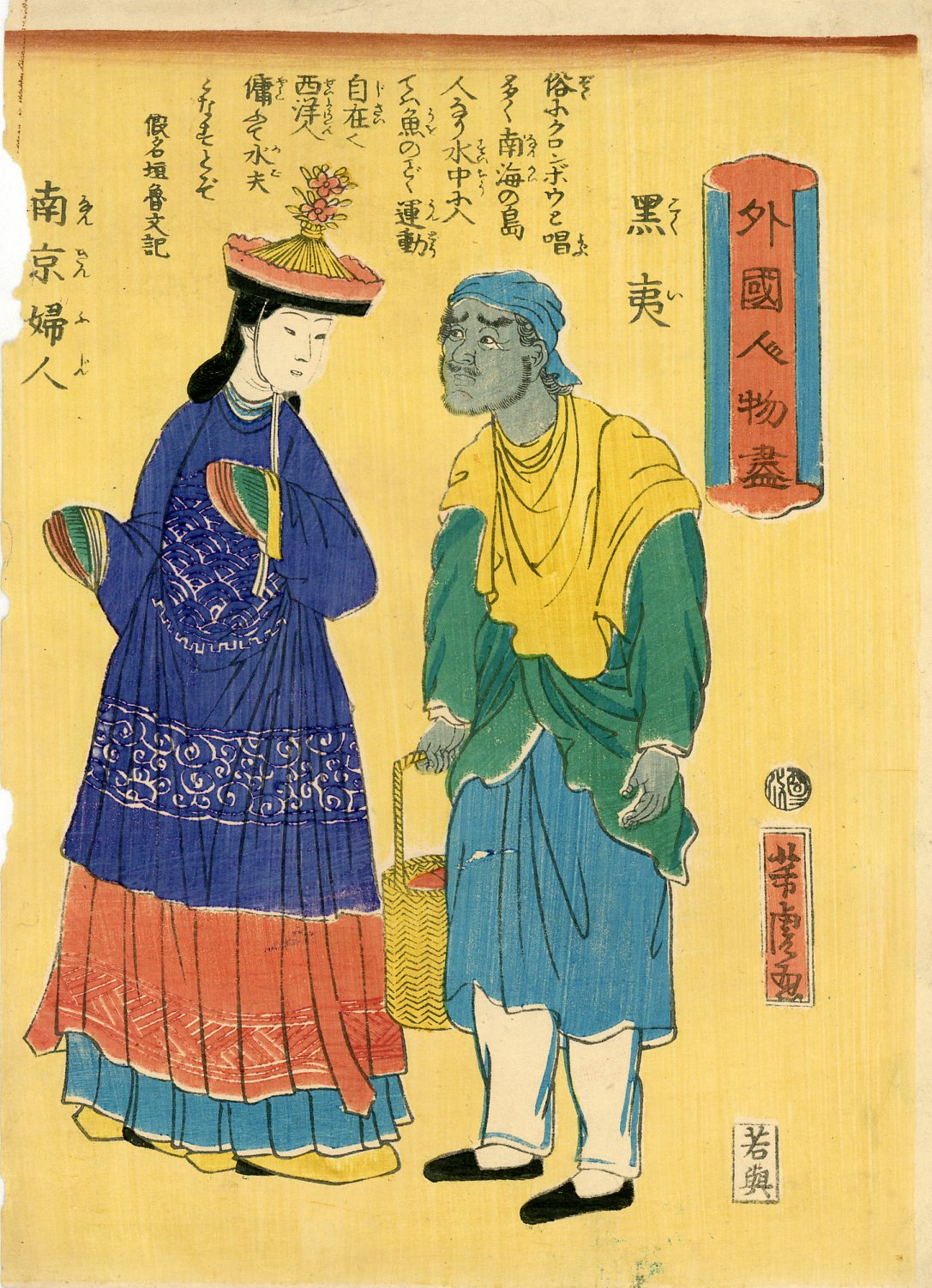Bunkyū-2 (1861-03/04) Kokui / Nankin fujin The woodblock print to the right was part of a series of depictions of people from other countries drawn by Yoshitora. Prints in the series bear approval seals dated the last month of Man'en and the first several months of Bunkyū on Japan's lunar calendar, which corresponds to the first half of 1861 on the Gregorian solar calendar. The opening of the ports and the arrival of thousands of people from other lands spawned the production of numerous wookblock prints portraying foreigners of different nationalities and scenes of life in the treaty ports. Practically all established artists and disciples drew such prints for local publishing houses, which employed the carvers who chiseled the blocks and the printers who made paper impressions from pigmented blocks. The printing houses owned the blocks and directly sold or distributed the prints. The drawers, like the carvers and printers, were generally hired hands. Prints associated with Yokohama are called "Yokohama-e" (横浜絵), but print dealers commonly use the term to include all prints which depict foreigners and their lives in late Edo and early Meiji Japan. "Nagasaka-e" (長崎絵) generally refers more specifically to prints and paintings associated with Nagasaki before the opening of treaty ports, when Japan limited trade to mostly Dutch and Chinese vessels in Nagasaki, which had separate quarters for Dutch and Chinese. Treaties of amity and commerce with the United States and four other countries -- Holland, Russia, Great Britain, and France -- were signed in this order in 1858. The treaties provided for the opening of treaty ports with extraterritorial foreign settlements in Kanagawa (Yokohama) and Nagasaki on 4 July 1859. Treaty ports and settlements were opened in Niigata on 1 January 1860 and Hyōgo (Kōbe) on 1 January 1863. An earlier treaty with Russia in 1855 established ports and settlements in Shimoda and Hakodate in 1855. But the Shimoda port and settlement were closed in 1859 when provisions were made for foreign embassies to operate out of a settlement in Edo, later Tokyo. The foreign settlements in the treaty ports accommodated both the consulates of the foreign party states and the homes and businesses of their resident affiliates. Hakodate, with more space and fewer people, provided several locations for Russian and American legations, residences, churches, and businesses. Title cartouchesThe cartouche enclosing the main title represents the 2nd of at least 3 stages of cartouche designs. 1st-stage prints have an elaborate furled and curled cartouche that shows both the main series title (ge 外題 outer title) and the thematic subtitles (naidai 内題 inner title). The subtitles of "gaikoku jinbutsu" genre prints, which depicted people from foreign countries, were generally the country identifications of the people. 2nd-stage prints typically feature a simpler curled or flat cartouche that shows only the series title. 3rd-stage prints show series and identity titles without cartouches. Prints of the last 2 stages, possibly beginning with this print, have story texts, all of which are unsigned -- with the exception of this one, which is attributed to Kanagaki Robun (仮名垣魯文), the penname of Nozaki Bunzō (野崎文蔵 1829-1894), a late-Edo and Meiji popular story writer (gesakusha 戯作者) and news reporter. This print is also the only in the group that shows the publisher's name as "Wakayo" rather than "Shiba Wakayo". Story
Print particulars外國人物盡 黒夷 / 南京婦人 Drawn by Yoshitora (芳虎) See Gaikoku jinbutsu zukushi (外國人物盡) for information about the series and other prints in the series. |
Servants in other Yokohama prints
Several other Yokohama prints depict dark-skinned people, most as domestic servants attending their employers -- or "keepers" or "masters" in the sense that such employees generally lived with the family they served or in nearby quarters. Some may have been brought to Japan as indent1ured (bonded) servants or possibly as chattel slaves.
Servants in Nagasaki paintings and prints
Dark-skinned domestic servants and attendants are depicted in numerous woodblock prints and paintings related to Nagasaki. Here are some examples.
